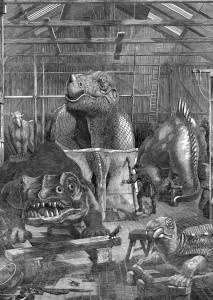Now I’ve recovered from the unbearable strain of watching Crystal Palace’s game against Sheffield Wednesday and can breathe a sigh of relief as we’ve avoided relegation, I can get back to the Crystal Palace itself and continue my musings on some of its representations in literature.
The Crystal Palace first appeared in fiction in the year it opened, in Henry Mayhew’s novel 1851: Or, The Adventures of Mr and Mrs Sandboys, the supposedly comic tale of a family which initially refuses to be taken in by the hype of the Great Exhibition, and then when they finally decide they should go after all are thwarted by a series of misadventures. I’m not going to pay it any attention now, partly because I’m more interested in the palace’s permanent home in South London, but mostly because it’s absolute trash and I haven’t managed to get through it yet. If you’re interested, here’s an article by Karen Chase and Michael Levenson.
George Gissing’s The Nether World, published in 1889, is one of the most depressing novels I’ve ever read (and I say that as someone who works on Dostoevsky and Shalamov). Amidst the unremitting misery of poverty, alcohol abuse, violence and exploitation of people who are completely unable to escape their fate, one might imagine that a bank holiday trip to the Crystal Palace by some of the characters to celebrate Bob and Pennyloaf’s wedding would provide some light relief from the grim reality of Clerkenwell, but no such luck. It’s depicted as a philistine place of mindless amusement whose sole object is to relieve the poor of their hard-earned cash. As the trip degenerates into drunken violence — thereby setting the tone for the Hewetts’ abject marriage — we are left in no doubt that the palace represents the worst of civilization.
The Crystal Palace appears in a couple of works by the children’s writer E Nesbit. The fireworks at the palace act as a backdrop to the 1900 short story The Ice Dragon, or Do As You Are Told, but for me The Enchanted Castle (1907) is more interesting. The only concrete (no pun intended) reference to the palace is to Waterhouse Hawkins’ dinosaur sculptures coming to life.
But the whole image of the enchanted castle also seems to spring from the atmosphere of the palace and park. Elsewhere in children’s literature, the Crystal Palace features in Daisy Ashford’s The Young Visiters (written 1890, published 1919).
Lawrence Durrell’s The Black Book (1938) is set at the Queen’s Hotel (in the novel called the Regina) on Church Road, Crystal Palace. Personally I think it’s a pretty awful, self-indulgent book, but the setting does interest me — the local area is quite strongly evoked (some great comments about ladies from Penge), but the Crystal Palace, which burnt down while Durrell was writing the book in 1935-6, is much more of an absence than a presence; I think it’s only mentioned once. It’s also significant for me because of a number of references to Russians and to obviously Dostoevskian themes, which in particular echo Notes from Underground.
There are also direct Dostoevskian references in Peter Carey’s wonderful novel Oscar and Lucinda (1988), in addition to the central theme of gambling. As Lucinda’s obsession with the Crystal Palace leads to her buying a glassworks and designing a glass church — ‘a Crystal Palace but not a Crystal Palace’ (p. 366) — a similar conception of the palace as an absence seems to arise. These are the sorts of connections I like exploring. There are other recurring themes in these texts, but I’ll leave those for another time.


gyuri
/ May 4, 2010Check out also Castelli di rabbia by Alessandro Baricco, which appeared in English as Lands of Glass, Penguin 1992. (according to wikipaedia http://en.wikipedia.org/wiki/Alessandro_Baricco)
an amazing book
Sarah Young
/ May 4, 2010Thanks for the tip! I’ll definitely check that out.